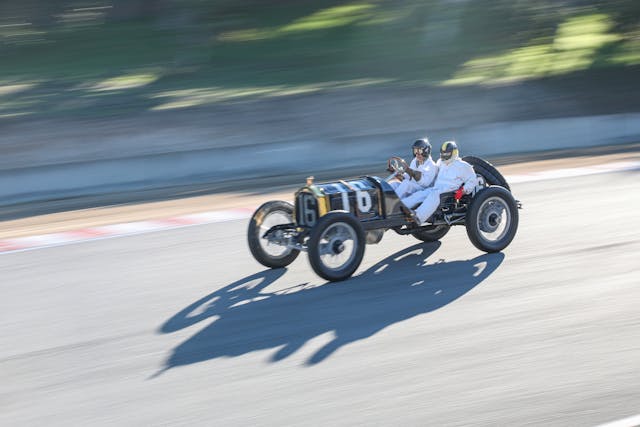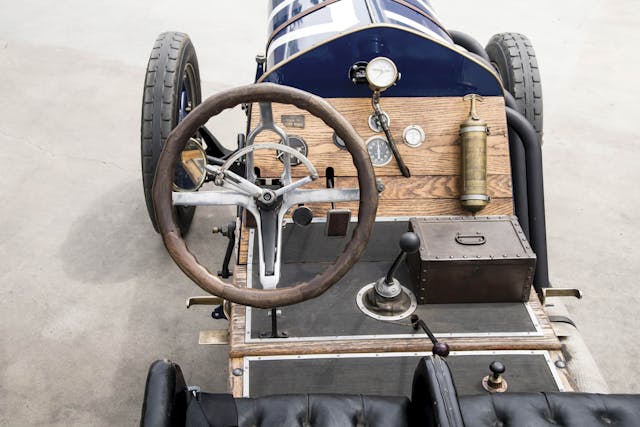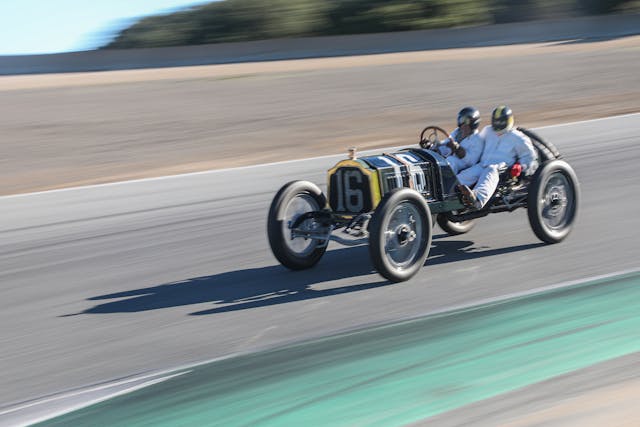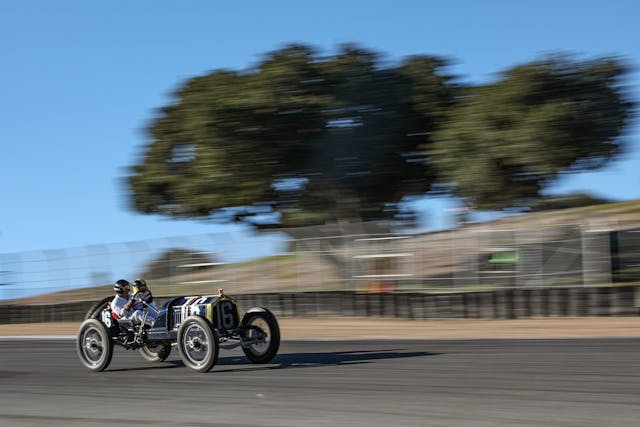Hot laps at Laguna Seca in a 1911 National? That’s the Ragtime Rush
In 1911, the morning after the first Indy 500, The Indianapolis Star listed on page one the butcher’s bill: Samuel P. Dickson, mechanician, Amplex No. 44, “dead;” David Lewis, mechanician, Lozier No. 34, “fractured left hip and left foot cut;” C.L. Anderson, mechanician, Case No. 8, “run over; bruised knee and shoulder,” and so on. When Brian Blain called me the week before this year’s Rolex Monterey Motorsports Reunion to ask if I would drive his 1911 National 40 Speedway Roadster for four days at Laguna Seca, thoughts of that carnage went barrel-rolling through my mind. For half a second. Then I said, “Yeah, absolutely.”
You may recall from our 2018 magazine feature, “Ragtime Rush,” that Blain is a former California walnut farmer obsessed with race cars from before the Great War, when the young automobile was like your typical 2-year-old kid: loud, messy, leaky, difficult to handle, and prone to breakdowns. Blain—who liked our headline so much that he swiped the name for his group, Ragtime Racers—runs vintage events each year with like-minded old souls who bring out their Marmons and Knoxes and Model T speedsters for “demonstrations.” No, they don’t actually race because they don’t meet any of the safety requirements adopted after about 1922. For one thing, the Ragtimers prefer to don period coveralls and leather helmets (when they can) because you look a bit silly dressed like today’s carbon-Nomex cosmonauts while gunning for a corner in an Edwardian parlor chair 4 feet off the ground. They also eschew seatbelts; in this time period, your chances in a crash were better soaring on the winds than staying aboard.

When I arrived, Blain’s team—including staff mechanic Bill Bennett, his volunteer squad of high school shop students, plus anyone wandering past with a vague understanding of magnetos—was absorbed. Blain gave me a quick tutorial on the National’s start-up procedure: Open the fuel valve; furiously stroke the cockpit hand pump that pressurizes the fuel tank; pour raw gas into the primer cups atop the 450-cubic-inch four-cylinder that has pistons the size of mayonnaise jars and valves bigger than the forget-me-nots at Windsor Castle; have your mechanic advance the throttle slightly and fully retard the spark so the hand crank doesn’t break your arm; and give the handle a swift yank. Do it right and the engine Chitty Chitty Bang Bangs to life. Oh, if you’ve forgotten to first select neutral, the car may then run you over.

I had questions, but Blain was off, trying to sort out why his 1916 Sturtevant Romano Special was throwing a conniption. When the paddock stewards blew their whistles, about a dozen ancients rolled out. The National’s clutch was easy, the center gas pedal at least as progressive as that of a Caterpillar D8. The transmission felt like it had the same gears that raise drawbridges. Without synchros to help, moving the three-speed shifter that rises up like a brass-plated ski pole outside the cockpit was like shepherding Hannibal’s elephants over the Alps; both force and finesse were required. Once, I tried downshifting to second to hasten the slow chug up the hill to the Corkscrew. I thought I matched the revs like Barney Oldfield, but the rear tires locked up and the whole car slewed sideways like it had just dropped anchor in the next county.

Throughout the week, various friends took turns in the mechanician’s chair, madly fibrillating the fuel pump while holding on for dear life and reciting the Lord’s Prayer. We weren’t racing, but at one point, the National hit 65 red-hot mph in pursuit of another National that had actually run in the first Indy 500 (winning average speed: 74.6 mph). Right after we passed them, I nailed an inside curb hard enough to launch the left front wheel in the air. My friend John Lacey swore he saw both the front and back of the wheel at the same time. Back in the paddock, we tugged on it. It seemed OK, you know, for wood.
I’m hoping Blain calls again. I’m pretty sure I can shave another minute or two off my lap times. Not that I was racing.



